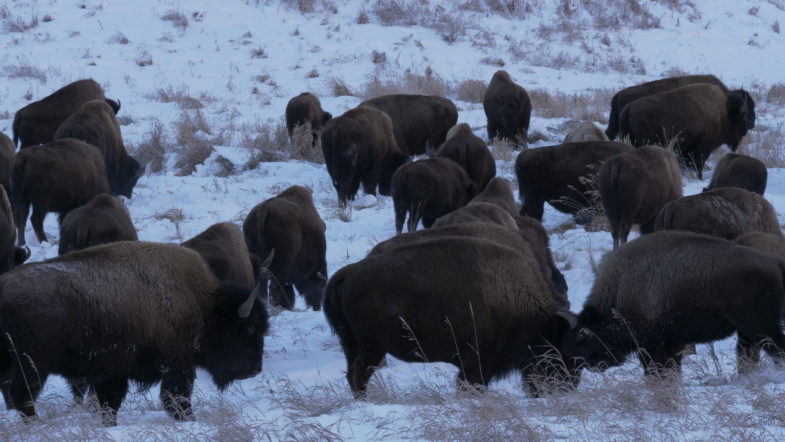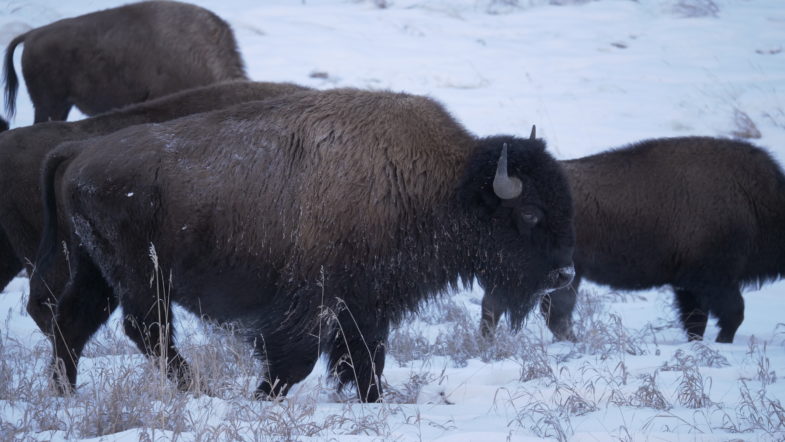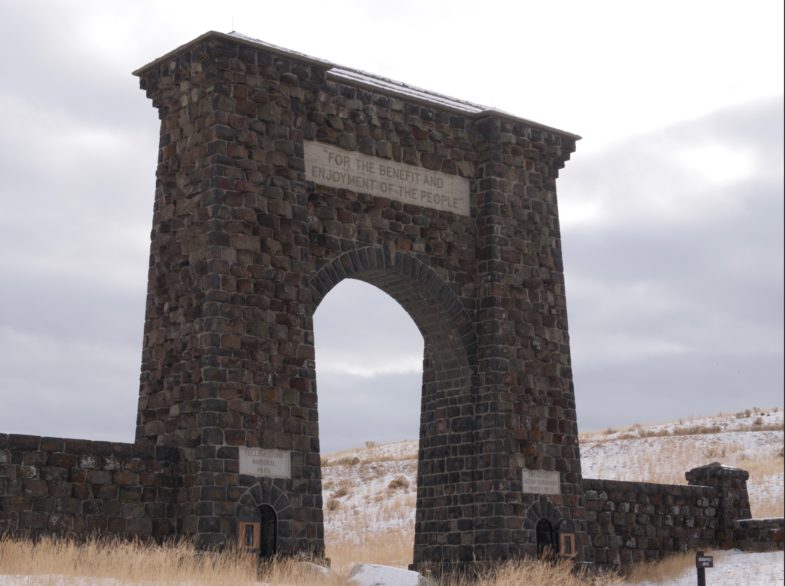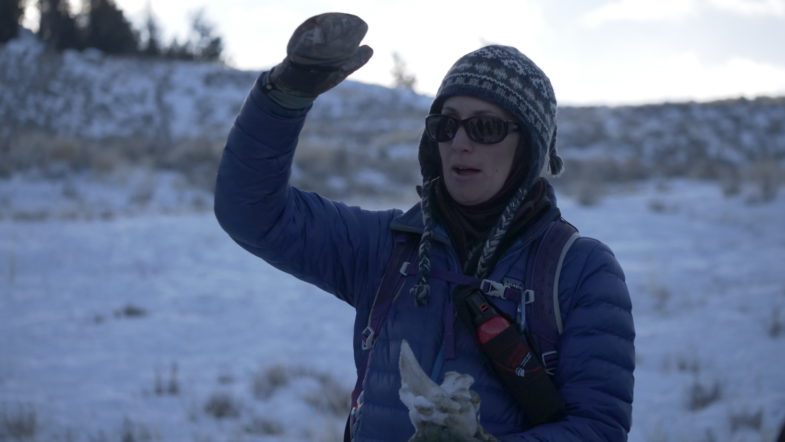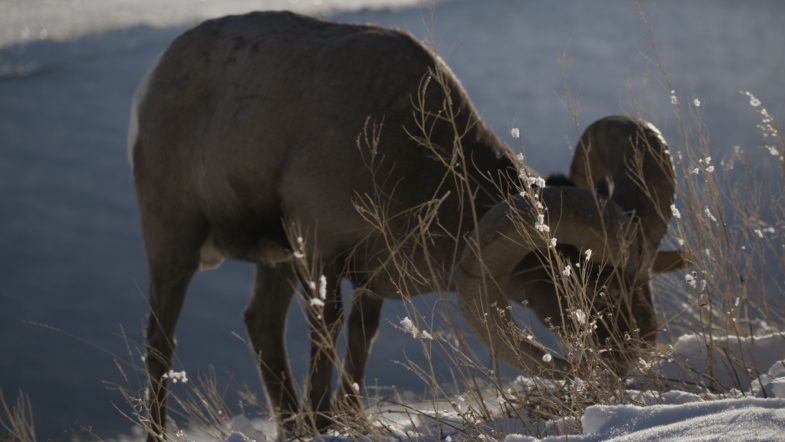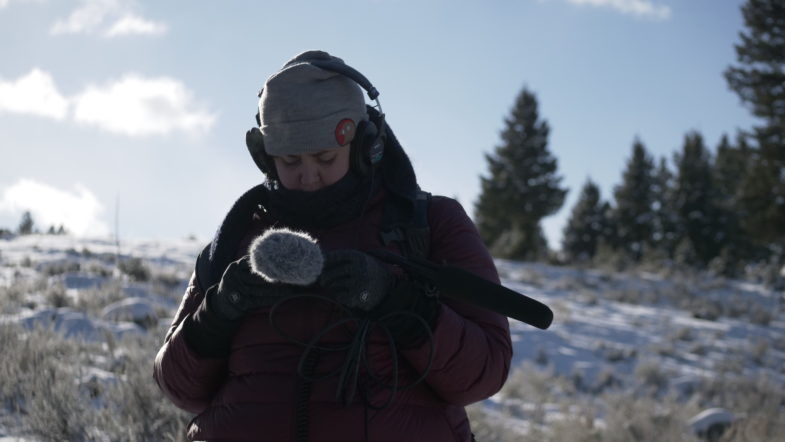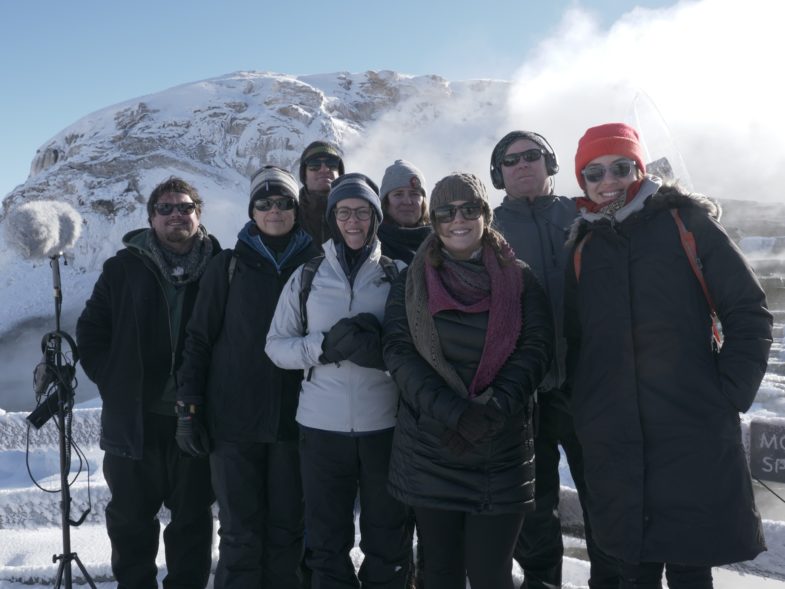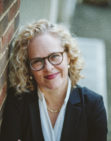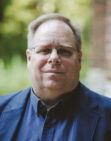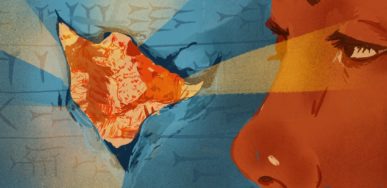[00:00:01] Kurtis Schaeffer I'm Kurtis Schaeffer.
[00:00:02] Martien Halvorson-Taylor And I'm Martein Halvorson-Taylor. And this is Sacred & Profane.
[00:00:07] Kurtis Schaeffer In December of last year we sat on a small mountain road in one of the strangest and most beautiful traffic jams I have ever been in.
[00:00:27] Martien Halvorson-Taylor Fifty or so American bison ambled down a hill across the road and into a gulch to reach a stretch of snow covered grass.
[00:00:38] Kurtis Schaeffer We could hear the bison walking through the snow. Pushing it aside with their massive heads to find grass. Calling to each other.
[00:00:51] Martien Halvorson-Taylor These bison are just some of the thousands that roam Yellowstone National Park.
[00:00:59] Martien Halvorson-Taylor They're all descendants of 23 buffalo. Perhaps the only wild bison who escaped slaughter across the North American planes in the 1800s.
[00:01:09] Kurtis Schaeffer Yellowstone became their home almost by accident when the land all around them was set aside as the country's first national park on March 1st 1872 we came across evidence of bison. Almost everywhere we went in the park. If they weren't passing in front of us you could see the snow they had churned up searching for grass along the valleys. And more permanent remains.
[00:01:33] Virginia Miller As well. Come on in here there's a few. Kind of scattered around.
[00:01:40] Martien Halvorson-Taylor This is Virginia Miller, a lead instructor at the Yellowstone Forever Institute, and our guide in the park. She bent down to brush snow off a large bison femur. With. Huge vertebrae built to support the bison as large head are scattered around to.
[00:01:58] Virginia Miller These. I think I've been here about six years. The head disappeared about four years ago. So. Of course in the national park it's illegal to take anything natural or historical out but... doesn't always work. I like to think that the people that take things just don't know any better.
[00:02:27] Virginia Miller When Yellowstone was established there's wildlife all over the West. So it was kind of an unintentional sanctuary.
[00:02:35] Martien Halvorson-Taylor In fact the act that dedicated the land as a national park land that was deemed beautiful but not useful has a lot more to say about people than it does about him.
[00:02:47] Reader An act to set apart a certain tract of land lying near the Yellowstone River as a public park. The tract of land in the territories of Montana and Wyoming is hereby reserved and withdrawn from settlement occupancy or sale. Under the laws of the United States and dedicated and set aside as a public park or pleasuring ground for the benefit and enjoyment of the people. And all persons who shall be located or settle upon or occupy the same or any part thereof shall be considered trespassers and removed they are from.
[00:03:24] Martien Halvorson-Taylor Right from the start The Act created a split that we've been struggling with ever since. On the one hand the people that were meant to benefit from the park were tourists largely coming from the eastern United States and the interlopers on the other hand the trespassers who are meant to be removed. These included the Native Americans who had been living within around and across the new park's borders for centuries. And animals were carefully managed more to provide enjoyment for visitors than to preserve a landscape.
[00:03:57] Virginia Miller Park managers were more concerned with human recreation, and what we were doing to manage wildlife was purely for the benefit of humans. People like to fish, and so early park management stocked rivers and lakes with non-native fish. And then to save the fish, they would do things like kill otters or pelicans. Animals that we like to see now. And so even though there's no fence around the park we've developed more and more and more whereas animals used to range far and wide away from this place. Now it's much harder for them to go out of it. These animals that don't know where that boundary lies are essentially finding out because when they go there they're they're turned back. So it's become even more of an island of sanctuary whereas it used to be kind of just like everywhere else.
[00:04:55] Kurtis Schaeffer Virginia talks about Yellowstone as a sanctuary and her use of this word sanctuary is why we went to Yellowstone. Sanctuary is a word imbued with explicit religious meaning. The original idea was a place that's made sacred by setting it apart with boundaries drawn around it. That seal it off from the mundane world and that's not new.
[00:05:18] Martien Halvorson-Taylor Many of the early champions of the National Park System saw it in explicitly religious terms as the nation's Garden of Eden. For example take the famed naturalist John Muir who wrote a guide to the first national parks. He loved the American landscape and wrote about it in language that is saturated with Biblical allusions to the Psalms and to the Book of Genesis.
[00:05:47] Reader (John Muir) Wander here a whole summer if you can. Thousands of Gods wild blessings will search you and soak you as if you were a sponge. The big days will go by uncounted, but that time will not be taken from the sum of your life. Instead of shortening it, it will indefinitely lengthen it and make you truly immortal. Never more will times seem short or long, and cares will never again fall heavily on you, but gently and kindly as gifts from heaven.
[00:06:26] Kurtis Schaeffer We wanted to explore what happens when a religious concept like making a sanctuary becomes a secular bureaucratic project. What happens when a government draws a border around a piece of land a border that sometimes cuts straight across natural boundaries. And how does that border change the land inside and outside of the border.
[00:06:50] Martien Halvorson-Taylor How does this invisible but powerful boundary affect people animals and the environment itself. We'll be talking to people like Virginia who live and work in and around the park about what that line means.
[00:07:15] Kurtis Schaeffer Speaking of buffalo they are a perfect example of what happens when you create a boundary between the park and everything else inside the park. They became a protected species.
[00:07:26] Mike Meese When you look at the history books and things like they first sent out the U.S. Calvary to stand guard around those so that poachers wouldn't have eliminated them.
[00:07:39] Martien Halvorson-Taylor This is Mike Meese. He's one of the founders of the Buffalo Field Campaign a group that tries to advocate for the Yellowstone region's bison population a herd that now numbers over 3500. It's a shadow of the historic population of bison in the American West. Accounts from the 19th century describe herds of buffalo stretching for miles and numbering in the tens of thousands. The total bison population in 1800 could have been as high as 60 million.
[00:08:14] Mike Meese The Sacred herd that we have here in Yellowstone are the last of the direct descendants of what they guessed to be the 30 to 60 million that roam North America. And that's what makes these animals so sacred and special.
[00:08:30] Kurtis Schaeffer If left to their own devices Buffalo will roam to find ideal habitat throughout the seasons. They migrate in large groups for hundreds of miles along river valleys looking for fresh water and grass.For much of their history as a species, that tendency to roam wasn't a problem.
[00:08:47] Mike Meese This year isn't a good example because we really haven't had much snowfall yet. But when you see the Buffalo travel through the thick winter terrain they always walk in single file and when the first Buffalo gets tired he here she steps to the side and lets the whole procession go by and then they jump on at the end where all the work has already been done and it's easy. And then of course not only did the buffalo benefit of that you'll see that all follow the same trails you'll see that deer and so they they helped the entire ecosystem survive for much of their history as a species that tendency to roam wasn't a problem.
[00:09:29] Kurtis Schaeffer But in the 21st century those migrations bring conflict. Mike says bison liked to live in the same kind of places that humans and cattle do in Montana. That means river valleys where there are now ranches farms and towns.
[00:09:44] Martien Halvorson-Taylor Some ranchers view them as competition taking grazing land from their cattle. Bison in Yellowstone also carry a common bacteria that's been linked to stillbirth in domestic cattle. Although transmission between bison and cattle hasn't been documented near Yellowstone. Bison can also live for around 15 years in the wild and the herd can grow quickly. The park can't support an infinite number of them.
[00:10:19] Kurtis Schaeffer So a compromise was worked out between federal state and tribal agencies. The bison have to stay inside the park. If they leave, they can be hunted in season. And the Park Service calls the herd most years. That is to say kill some of the herd to rein in their numbers. Mike says that in 2017, between legal hunting and culling of bison inside the park roughly 12 hundred of Yellowstone's bison were killed.
[00:10:48] Mike Meese So we're talking about approximately a quarter of the entire Yellowstone herd died last year. And this is almost an annual practice. Yellowstone is a high elevation plateau. It's not ideal habitat year around habitat and these animals have to be able to migrate because you can't make arbitrary lines and expect wildlife to follow your lead like I always say no matter what your management plan does you're never going to stop these buffalo from being above. Set things up for disaster because we base things on what humans want and not what the wildlife needs. And until we can learn to listen for the wildlife they tell us all the time what they need they show us what they need. But we just don't want them to need that all too often.
[00:11:54] Kurtis Schaeffer The park has come to be a place that contains some of our last wild bison. Providing them a safe but limited sanctuary and they cross the border at their peril. Those borders also keep out human development and human inhabitants.
[00:12:18] Martien Halvorson-Taylor Yellowstone wasn't an untouched wilderness when it became a park. People were living within its new boundaries and had been for centuries. At the time the park was created that included members of the Crow Tribe. They had been promised land including what's now Yellowstone. When they signed a treaty with the U.S. government just four years before.
[00:12:45] Shane Doyle I like to think of Montana as kind of the mecca for Plains Indians has been for a very long time.
[00:12:52] Kurtis Schaeffer This is Dr. Shane Doyle.
[00:12:54] Shane Doyle I'm a local boy. I guess you could say a member of the Crow tribe and my tribe has been around here for a very long time. We don't know exactly when or how long we've been in this region but our oral traditions place us back about five hundred years ago.
[00:13:18] Kurtis Schaeffer In the centuries that the Crow people lived in the region they moved around following food sources as the seasons progressed. And like many of the Plains tribes who lived in and around Yellowstone by moving they maintained strong connections to a much larger world.
[00:13:36] Shane Doyle They traded just as much as they hunted and gathered. You know they developed their own. The world's only universal language. Playing sign language. Forty four different tribes spoke the same language. And you know it wasn't because of hearing impairment. It was because of the trade networks that were so crucial to their their way of life from Edmonton Alberta all the way down to the Gulf of Mexico. Even to this day people don't speak the same language in that region.
[00:14:06] Kurtis Schaeffer Treaties and the borders they imposed fractured that large interconnected world of hunting gathering and trading that Shane described. And within four years of signing a treaty at Fort Laramie, the land that had been promised to the Crow became a part of Yellowstone Park.
[00:14:33] Martien Halvorson-Taylor Stories that justified and promoted the park as an untouched paradise proliferated. These stories claim that few Native Americans had ever been there because it's guys ears and thermal features were seen as threatening or even coerced. The implication was that not only did Native Americans have no real claim to the park but they weren't capable of appreciating its beauty in the same way that civilized white Americans could.
[00:15:02] Shane Doyle So a lot of people been here for a long time. They weren't afraid of this place. Which is what people are. Led to believe. I think. That Native Americans were kind of afraid of Yellowstone Park or they avoided it or. You know which is not true at all. They were here a lot all the time. And I think they enjoyed coming here. They liked it. So why would anyone NOT want to you know get that extraordinary feeling of humility and humbleness that comes with something that's so much bigger and older and more significant than you.
[00:15:44] Kurtis Schaeffer Shane has conflicting emotions about modern Yellowstone. On the one hand it can be a stark reminder of what has been lost.
[00:15:54] Shane Doyle My great great grandfather signed a treaty that said it was supposed to be the law of the land. This should be my property right here. I'm standing on. Oh yeah let's start with that. And we'll take back all the Yellowstone. Basically the whole Yellowstone River.
[00:16:19] Kurtis Schaeffer But the idea of Yellowstone as a sanctuary as a place that's set aside from everyday use there is something in that idea that he believes would ring true to the people who lived here before.
[00:16:34] Shane Doyle They had no in their wildest imagination knowledge of the billions and billions and billions of people that we share this planet with. And that we have to set something aside otherwise people will get at it. And I think if they had understood from that context what the sanctuary was they would have advocated for that.
[00:17:02] Martien Halvorson-Taylor As we were packing up our equipment, Shane mentioned one last thing. He says Yellowstone is part of a much larger fight in Montana about who has access to and rights over public land a huge swath of the state. About a third of the total area is managed by the federal government, and there's constant debate by ranchers, hunters, environmental groups, and tribal governments about how those lands should be used. Who gets to determine how this is a sanctuary and for whom.
[00:17:38] Shane Doyle We've been really gone round and round over public lands here in Montana. But people by and large do support public lands. That's about as sacred as it gets in America. I mean you could say they're not really sacred but I you know I don't know about that. Because that means that we we said we value that more than money.
[00:18:09] Yellowstone, like all sanctuaries, is defined by its boundaries. And while humans may mark these boundaries, they can't protect the place from larger forces forces like climate change.
[00:18:21] Mike Tercek It's hard to be objective about a place like Yellowstone because I sort of feel like a brother to it or something.
[00:18:27] Kurtis Schaeffer This is Mike Tersek. He's an ecologist who studies how climate change is affecting the park now and what its future might be.
[00:18:35] Mike Tercek When you think something like this is threatened it's hard to be a scientist and just present just the facts. You want the next 20 or 30 years to turn out in a very specific way. If you care about a place like this as much as I do it's not just an experiment in science.
[00:18:49] Ashea Mills I came out to Yellowstone in 1995. Fell deeply in love with the landscape started guiding and so it's been this is my 20th year guiding.
[00:18:58] Martien Halvorson-Taylor And this is Ashea Mills. Like Mike, she felt drawn to Yellowstone on a personal level. Both of them have worked in and around the park for decades, which is how they first met.
[00:19:10] Ashea Mills We were both working at Old Faithful back in the time and so it took us a few years to get together but now we have a house and a kid just around the corner and live full time in Gardener.
[00:19:20] Martien Halvorson-Taylor In the time they've lived and worked in the Yellowstone ecosystem, the symptoms of climate change have become more and more visible. Winter is growing shorter with fewer days below freezing and fewer with snow on the ground in the summer. Wildfires are larger and more frequent. And while as a scientist, Mike cautions that it's dangerous to rely on anecdotes over data, there's a moment he just can't get out of his head.
[00:19:57] Mike Tercek In 1995 I had a job where I was the last person in the park with a tow truck driver until the very end of the season. I think one day I sold three gallons of gas the whole day. When you got past mid-October in late October the road would close every other day sometimes for several days at a time. And if someone did make it it was like a big achievement. Often I'd have to go with the tow truck and drag him out of the ditch. But then this fall I think it was October 26 that we were down at Old Faithful. So was the same time of year. Twenty three years later, it was 70 degrees.
[00:20:35] Kurtis Schaeffer This is a tension that lies at the heart of sanctuaries like Yellowstone and it's made worse by rapid climate change. We seek to preserve an untouched version of the land but landscapes are dynamic they change constantly especially when humans are involved.
[00:20:53] Ashea Mills I think originally the idea of Yellowstone was to sort of have this vignette but it had already been so altered. You know my early years guiding, I used to talk about how you know as much as possible or try not to put anything in or take anything out. But then the more you hear in the more you learn about our you know, things like spraying the northern range with DDT and you know some really heavy handed management that's gone on certainly before and then even since the park was established. So when we talk about trying to save Yellowstone in quotes or you kno...what is it that we are trying to save? That is a part of the conversation. Is it a vignette from 1872? Is it post DDT spraying? Is it the 1942 version? Is it what it would look like ten years ago, or when I first got here and thought it was perfect?
[00:21:49] Martien Halvorson-Taylor There is another question raised by climate change right now the threats coming to Yellowstone are environmental but as the country heats up a relatively cool place like the mountains of Montana or Wyoming becomes an even more attractive place to live.
[00:22:04] Ashea Mills The second greatest threat to the ecosystem is development. One of the reasons why Yellowstone that set aside in the early end was because it was sort of this useless piece of land. You know we couldn't ranch it. They didn't know about any big mother loads of gold or some other precious metal and so you know they took a good look and said...well can we ranch? Can we farm it? You know it's under snow half the year, it's inaccessible practically. So sure, we'll make it a national park.
[00:22:30] Martien Halvorson-Taylor And while Yellowstone may not have gold it's full of resources that are going to become increasingly important as our climate warms - especially water.
[00:22:39] Ashea Mills Looking down the road for Yellowstone is things like water availability. When downstream we have people literally dying for lack of water hydrological dams have been proposed in Yellowstone in the past. They've gotten defeated but I think that that's something that's going to revisit us in the near future and who's going to care about the Grand Canyon of the Yellowstone when people are dying downstream.
[00:23:11] Mike Tercek You've heard of sliding baselines, I'm sure. You're familiar with that phrase where you accept what you have and that's the normal or the okay. And every generation does that so you keep having a loss. In some ways that's a mercy I think about that for my daughter she'll never remember the Yellowstone that I do and so she won't feel the loss of it. So it's good and bad. It's less emotionally hard, but you also if you take it to an extreme you and giving up everything that matters because you keep compromising.
[00:23:43] Ashea Mills The challenge is caring so deeply. You know me having this this landscape is such a meaningful part of our lives. And the choice to have a daughter too. You know Mike mentioned and these are the kind of things that motivate Mike and I to do a lot of the work that we do and deciding to have a kid and knowing what we know. But her name Aria Hope — you know, "a song of hope." You have to have hope because if you don't you just won't get out of bed in the morning. You know, why bother.
[00:24:19] Kurtis Schaeffer At the end of the day humans create sanctuaries. We make the rules.
[00:24:24] Martien Halvorson-Taylor Each of our guests today is deeply invested in the park. For some it is part of their professional lives. But it is moreover a part of their emotional lives and they have made it a sanctuary in their own unique and distinct ways.
[00:24:40] Kurtis Schaeffer And each is conflicted about the very nature of the border that sets the park apart from the rest of what is called the Greater Yellowstone Ecosystem. This is a border that has kept Native peoples out redefining right under them. What land they can and cannot have free access to. This is a border that is completely arbitrary to the buffalo. Who in their very nature want to roam freely over it across it and back again.
[00:25:06] Martien Halvorson-Taylor And this is a border that ultimately feels too porous to Mike and Ashea. It cannot keep out climate change. The government and the early nationalist movement created it to be a sanctuary setting it apart as a special place. Reading scribing it in the language of the sacred to make a place a sanctuary in this way imbues it with great power. But again and again we were struck by the arbitrariness of it.
[00:25:35] Martien Halvorson-Taylor The park grips us with its incredible natural beauty its deep histories its power to protect what we might otherwise lose but the deep irony is that climate change doesn't care and it turns out that what we do as humans elsewhere changes the borders redraws the picture alters the sanctuary. What Yellowstone is in the future as a national sanctuary may not be what Yellowstone is now. As our guide Virginia reminded us as we left the park for the last time.
[00:26:11] Virginia Miller When Yellowstone become a national park in 1872. We didn't really know what we were doing. I say 'we' like I was there. But yeah, throughout time the park has come up with different ways to manage wildlife, people, recreation. Yellowstone didn't come with an owner's manual. We're still making it up as we go. So, all these controversies. You know we can't just look at something and go oh this is how we're supposed to do it. We have to figure it out. We don't know what right and wrong is yet.
[00:26:53] Kurtis Schaeffer Sacred and Profane was produced for the Religion, Race & Democracy Lab and the Sanctuary Lab at the University of Virginia. Our senior producer is Emily Godek. Our program manager is Ashley Duffalo.
[00:27:07] Martien Halvorson-Taylor Special thanks to Matthew Burtner, Cassandra Fraser, Willis Jenkins, Luke Kreider, Erica Share, Ashley Tate, Devin Zuckerman, and Yellowstone Forever. Our readers were Cameron Mackay and Chris Walljasper.
[00:27:25] Kurtis Schaeffer Music for this episode comes from Blue Dot Sessions. You can find out more about our work at religionlab.virginia.edu, or by following us on Twitter @TheReligionLab. And if you like the show head over to iTunes or the platform of your choice to rate and review us. It really makes a difference for new shows like ours.
[00:27:46] Martien Halvorson-Taylor Speaking of the show this is our last episode for a while at least over the next few months will be getting season to ready for you. But in the meantime we'll be highlighting some of the great work our students are doing around the world on our website.
[00:28:26] Martien Halvorson-Taylor No bison were harmed or approached in the making of this show. The sound at the top of the show came from powerful microphones that could pick up these sounds while we were sitting safely in our cars. Do not try and record bison or any wild animal up close and personal.
In 1872, an act of Congress transformed newly acquired territory in the American west into Yellowstone National Park. The act declared that the land was “hereby reserved and withdrawn from settlement, occupancy, or sale under the laws of the United States…and set aside as a public park or pleasuring ground for the benefit and enjoyment of the people.”
And while it was our first national park, Yellowstone draws on much older thinking about sanctuaries. We often use the word sanctuary to talk about places like Yellowstone that have been protected from human development and industry. But it’s a word with deep religious roots. Traditionally, a sanctuary is a place that is set apart from daily human life and reserved for the divine.
Last winter, we traveled to Yellowstone to explore what happens when a religious idea like sanctuary is transformed into a secular and bureaucratic one. How has “setting aside” this land affected the people and animals who have historically lived within its borders? And can any man-made border keep out the effects of climate change?
How to cite this episode:
Halvorson-Taylor, M., Schaeffer K. (Presenters), & Gadek, E. (Producer). “Set Apart.” Sacred & Profane (2019, September 16).
Additional Reading
Carmichael, David L., et al., editors. Sacred Sites, Sacred Places. Routledge, 2008.
Farrell, Justin. The Battle for Yellowstone: Morality and the Sacred Roots of Environmental Conflict. Princeton University Press, 2017.
Holloway, Marguerite, and Josh Haner. “Your Children’s Yellowstone Will Be Radically Different.” The New York Times, The New York Times, 15 Nov. 2018, https://www.nytimes.com/interactive/2018/11/15/climate/yellowstone-global-warming.html.
Muir, John. Our National Parks. Dover Publications, Inc., 2019.
Nabokov, Peter. Restoring a Presence: American Indians and Yellowstone National Park. University of Oklahoma Press, 2016.
“Questions & Answers about Bison Management.” National Parks Service, U.S. Department of the Interior, https://www.nps.gov/yell/learn/management/bison-management-faqs.htm.
Additional Credits
Our guests were Shane Doyle, Virginia Miller, Mike Meese, Ashea Mills, and Mike Tercek.
Special thanks to Matthew Burtner, Cassandra Fraser, Willis Jenkins, Luke Krieder, Erika Share, Ashley Tate, Devin Zuckerman, and the Yellowstone Forever Institute. Our readers were Cameron MacKay and Chris Walljasper.
Illustration by Carson McNamara.


